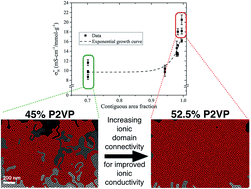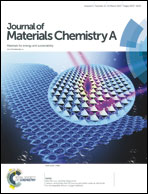Interconnected ionic domains enhance conductivity in microphase separated block copolymer electrolytes†
Abstract
Block copolymer electrolytes (BCEs) represent an attractive choice as solid-state ionic conductors for electrochemical technologies used in energy storage and conversion, water treatment, sensors, and data storage and processing. Unlocking the maximum ionic conductivity of BCEs requires an intimate understanding as to how the microphase separated structure influences transport properties. However, elucidating such knowledge remains elusive due to the challenging task of precisely engineering BCEs with a defined structure in bulk materials. In this work, we examined BCEs in a thin film format because it was amenable to attaining BCEs with a desired nanostructure. Specifically, we systematically investigated anion-conducting BCEs with different degrees of connectivity of the ionic domains. For the first time, we demonstrate that increasing terminal defects in the ionic domain from 1 terminal defect per μm2 to 20 terminal defects per μm2 (a relatively small amount of defects) decreased ionic conductivity by 67% compared to the maximum value attained. Conversely, maximizing ionic domain connectivity increased the ionic conductivity by two-fold over a non-ordered BCE film. These experiments highlight that microphase separation alone was insufficient for ameliorating ionic conductivity in BCEs. Rather, microphase separation coupled with complete ionic domain connectivity realized BCEs with significantly enhanced ionic conductivity.



 Please wait while we load your content...
Please wait while we load your content...